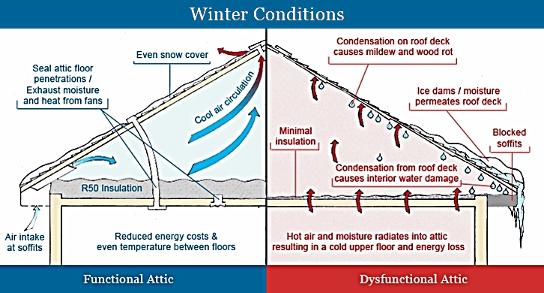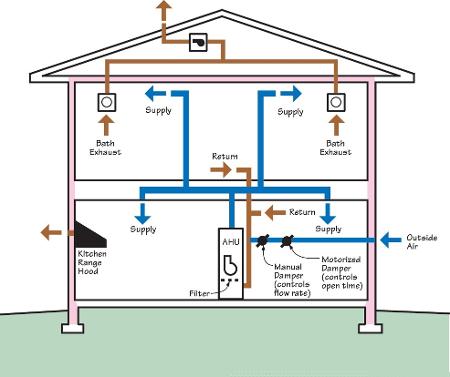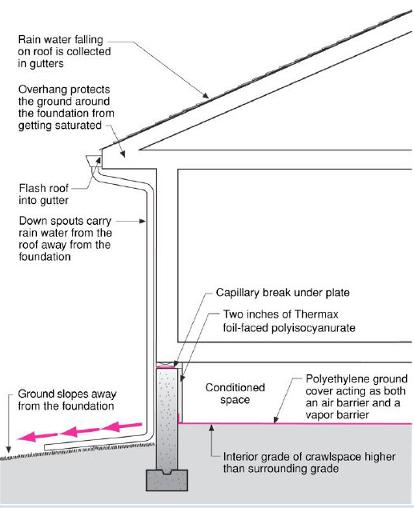Ventilation
Ventilation and Your Roof

Ice Dams
Contrary to popular belief, gutters do not cause ice dams. Ice dams on roofs form when accumulated snow on a sloping roof melts and flows down the roof under the insulating blanket of snow, until it reaches below freezing temperature air, typically at the eaves. When the melted water reaches the freezing air, ice accumulates, forming a dam, and snow that melts later cannot drain properly through the dam.
- Leaks through the roofing material
- Damaged ceilings and walls
- Damaged roof structure and insulation
- Damage or injury when the ice dam falls off
- Damage or injury from attempts to remove ice dams.

Solving the Problem
There are many ways to treat the symptoms, but proper air sealing, insulation, and attic venting are the best way to eliminate the problem.The way to stop ice dams from forming is to keep the entire roof cold. In most homes this means blocking all air leaks leading to the attic from the living space below and increasing the thickness of insulation on the attic floor.
Attics that are properly ventilated allow hot air to exhaust from the attic in the summer. Natural air flow in a well-vented attic moves super-heated air out of the attic, protecting roof shingles and removing moisture. The insulation will resist heat transfer into the house.
Properly ventilated attics allow warm and humid air to exhaust in the winter. This allows a natural flow of outdoor air to ventilate the attic helps keep it cold, which reduces the potential for ice damming (snow that melts off a roof from an attic that is too warm and then re-freezes at the gutters, causing an ice dam that can damage the roof).
The life of the roof is extended if the attic is properly ventilated. Most shingle manufacturers require proper ventilation to validate the shingle warranty.
- Install roof vents to increase air circulation in the roof cavity system.
- Keep inside air circulating with fans. You can also run the furnace fan.
- Reduce moisture build-up in the kitchen and bath by using the exhaust fans.
- Use a portable dehumidifier in the room where you have the condensation stains. To prevent problems, buy a dehumidifier that will shut off when the collector pan is full.
- Avoid venting your clothes dryer under your house or in your house.
- Check to make sure nothing is blocking the cold or warm-air registers.
- Install interior storm windows to keep condensation from forming on windows.
- Check the base of your house to make sure the skirting is well ventilated, the ground is covered with either rolled roofing felt or plastic sheeting, and the blackboard is intact

Exhaust Systems
Exhaust Only
An exhaust only system removes stale and moisture-laden air from the home. It works by extracting indoor air from a house while make-up air infiltrates through leaks in the building shell and through passive vents. Typically exhaust only solutions remove air from rooms where moisture is most often generated (kitchen, bathrooms and laundry room).
Supply Only
Supply ventilation systems involve the use of a fan to bring outside air into the home while air leaks out of the home through holes in the shell, fan ducts and vents. A typical supply ventilation system introduces fresh air into one or more rooms within the home.
Balanced Systems
Balanced ventilation systems, if properly designed and installed, neither pressurize nor depressurize a home. They introduce and exhaust approximately equal quantities of fresh outside air and polluted inside air, respectively.

Condensation
Understanding Condensation: Ever wonder why condensation forms on your windows—and what you can do to prevent it?
How Can Condensation Be Reduced?
- The key lies in controlling the humidity inside your home.
- Open a window
- Use exhaust fan
- Turn off humidifiers
- Add storm windows
- Replace existing windows with insulated windows
- Add waterproofing protection to basement floors and wall
- Vent moisture-generating appliances, such as dryers
- Vent kitchens and bathrooms
Day-to-day activities such as cooking, washing and drying clothes, heating and even breathing produce water vapor. Air can only hold so much moisture in the form of an invisible vapor, no matter what temperature it is.
When the air contains more moisture than it can hold, it reaches ‘saturation point’ and when this is reached, the moisture turns back into water and condensation occurs. The temperature reached at saturation point is called the ‘dew point’.

Why is My Basement Leaking?
Most of the time, when your basement is leaking, it is caused by some form of drainage problem outside the home. In most cases, this means your basement is leaking because the soil surrounding your foundation and the walls of your basement has become overly saturated.
Gutter System
To fix a leaking basement caused by gutters, you probably need to replace them. If possible, make sure that spouts send water at least four feet away from your foundation. Before rainy seasons begin, clean out all your gutters and make sure no mud or leaves might clog the flow of water. Installing gutter covers.
Grade of Slope
To solve this, you need to make sure that there is at least a small grade of slope from your house to the street, allowing for smooth water flow away from the foundation.

Solutions
Home moisture problems are complex to solve, especially with our unique climate of cold winters and hot, humid summers.In general, problems will occur whenever there is an imbalance between the moisture input to your home and the ventilation rate of your home. The thermal characteristics of building materials also enter into the mix. The solution often lies with some combination of reducing the moisture input, increasing the ventilation, and improving the thermal performance of the building materials.
Free Estimates
Call us today so we can assess your needs and provide you with a FREE estimate!
402-592-5577
Contents
